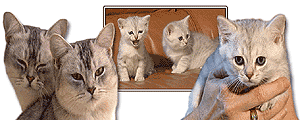Breed: Burmilla
Temperament: outgoing, friendly and sociable
Cost: from $550 (microchipped and desexed)
Lifespan: 15 years plus
Recommended for: families
Maintenance: low
If there were fashions in felines would the Burmilla represent the 1980s with their frosted hair and more eyeliner than Duran Duran? Even their name is contrived, revealing their Burmese-Chinchilla heritage.
History
The Burmilla developed as a result of an accidental mating between a lilac Burmese and a silver Chinchilla in the 1980s in England. Instead of ignoring the crossbred kittens the owner, Baroness Miranda von Kirchberg, established a breeding program to develop a cat showing the colour of the Chinchilla with the Burmese shape, coat and temperament. The Burmilla was first recognised in 1983 by the Cat Association of Britain and in 1984 was given international recognition. The first Australian litter was born in 1994.
There is some controversy about the breed around Australia. Only Western Australia, Queensland and New South Wales officially recognise this breed. Consequently it may be difficult to buy Burmillas locally.
Appearance
Burmillas have green eyes with stunning Chinchilla-like eyeliner. The coat is short, dense and soft, with a pale undercoat and darker tips or shading. The lips and nose are also outlined, or ‘pencilled’. Burmillas are medium-sized cats whose body type is closer to the Burmese than the flatter-faced Chinchilla.
Temperament
These are adaptable cats, being curious, affectionate and human-oriented. They can be wary with strangers but once introduced can happily become a ‘lap cat’.
Health
Burmillas are a fairly robust cat with a good temperament. One potential health problem, cystic kidneys, has come down from the Persian side but with responsible owners ultra-sounding breeding animals before they’re mated, the risk should soon be minimal.
Feeding
Burmillas are not fussy eaters and enjoy a balanced diet of raw meat, canned food, dry food and cheese but, as with other foreign-type breeds, they may be lactose intolerant and shouldn’t be offered milk – water is best. It would cost about $7 a week to feed an adult Burmilla.
Breeding
While these cats experience no kittening problems and are excellent mothers, achieving the ‘true’ Burmilla is extremely difficult as breeders strive to produce right combination of Burmese conformation, coat texture and eye colour and Chinchilla colouring.
Breeding programs must only use Burmese and Chinchilla cats, and it’s said to take five generations for the ‘true’ Burmilla to emerge. Longhaired kittens do occur, usually in the program’s second generation. In the UK – where they can be registered – they are known as ‘Tiffanies’. These cannot yet be registered in Australia but still make fine pets.
Housepet potential and ideal owner
Burmillas are excellent indoors and are suitable for flats and apartments. If kept inside all the time, cats need a scratching post, pot of grass and clean water. They make excellent family pets and ideal companions for the elderly.
Grooming
The coat does not matt and is easy to manage. It only needs a comb once a week. Due to the fact that these cats have a double coat and subsequently moult more often they are not very suitable for people with allergies to cats.
Popularity
The breed is still very rare in Australia and owners will have to join a waiting list for a kitten.
Contacts
Our story was filmed at Hindmarsh Cattery in Oakville NSW
Contact Robin Moller, phone: (02) 4572 3343
www.hawknet.com.au/~hrmoller/
email: [email protected] Burmilla and Tiffanie Silvertails of Australasia
(affiliated with Waratah State Cat Alliance Body)
Anne Sinclair (Secretary)
Phone: (02) 4681 8108
http//web.one.net.au/~shantinga
email: [email protected]



